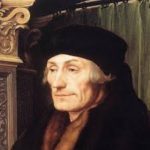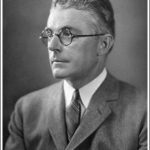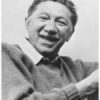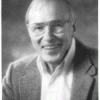
Erasmus
According to Erasmus the child coming to this world is raw material, a white piece of paper, man is not born with certain qualities, man is educated. The huge task of the people involved with education is to give this new born child the perfect education in its finest form. Later the supporters of the theory of the omnipotence of education increased and they combined the experiential philosophy of English Francis Bacon with the sensual philosophy of John Locke

L.S.Vygotsky
(1896-1936): The Russian psychologist who expressed the method of double development. He exposes a very interesting view about learning. Learning is one step behind maturity and this creates a zone of ability for development. “The only good teaching is the one that precedes development” he supported. Vygotsky’s theory is based on the view of the physical and social source of development and which supports that everything in man’s development happens twice, firstly on a social level and then on a personal level.

J.Piaget
(1896-1980): Swiss scientist representative of the Cognitive theory. Piaget supports the view that maturity is a necessary condition of learning and that the child must reach a certain level of maturity -depending on the stage- before it can be taught a new experience. According to Piaget the construction of the mental structure of the person is the result of the continuous effort of the person to find and sustain a balance between himself and his environment. He calls this effort adjustment. The adjustment event is described by three concepts: assimilation, accommodation and schema. Assimilation is the incorporation of the environmental data to the already pre-existent structure of the body. Accommodation, a reversal operation of assimilation, is the alteration of the cognitive forms/schema in order to assimilate the new data. Cognitive Schema is the structure and organisation of the person’s actions into a new structure of actions, under similar or analogy situations.
Piaget’s theory is considered to be among the cognitive theories with constructivist character that interpret learning as a) a continuous interchange of successive operations and b) as a result of the person’s creative activities in the environment. The source of knowledge is the internal and external reality.
Furthermore, Piaget pays a lot of attention to the social dimension of teaching, meaning the importance of expressing one’s opinion, the exchange of thoughts, dialogue, group co-operation among the students. Piaget emphasises “creativity” and “self discovery of new knowledge” as well as the authentic creative activities of the child and he strictly criticises the programmed learning.

Kieran Egan
Canadian curriculum theorist Kieran Egan (1997) offered a theory of cognitive tools as a possible replacement for several dominant theories of learning widely applied to education, including Piaget’s theory of cognitive stages, Dewey’s theories about the nature and goals of education, and applications of evolutionary theory applied to cognitive development and learning. Egan proposed that there exist five kinds of understanding (or cognitive tools) that individuals usually master in a particular order during the course of their development that reflect psychological, epistemological, and cultural factors. The first four cognitive tools that Egan proposes (Somatic, Mythic, Romantic, and Philosophical) mirror the characteristics and timing of Piaget’s stages of cognitive development (sensorimotor, pre-operational, concrete operational, formal operational).

J.S.Bruner
American J.S. Bruner as Vygotsky believes that all the subjects and themes can be taught at all ages effectively and efficiently as long as learning refers to the full understanding of the main principles and structure of the subject and as long as the methodology used to teach is the appropriate concerning the rhythm and the level of the intellectual development of the child. According to Bruner the understanding of the general principles makes the subject more easy to assimilate and this is the main way for a sufficient “transfer of learning”. The details of the subject must be placed in a structured, well-disciplined whole in order for them to be preserved in the memory. Students must be helped so as to realise the structure of a particular field of studying, because in this way it is more possible to remember the details and understand the principles that can be applied to plenty of different situations. Moreover, Bruner believes that when students are given specific predefined programmed material, they become too dependent on that. Students should be able to find their own ways of solving the problems. In that way, not only do they get more confidence in their abilities of learning but they also learn the way with which they can face similar problems in the future. Children learn how to learn while they learn. The discovery techniques that Bruner presented include a) the emphasis on the opposite, b) the stimulation of the guessing ability c) the promotion of active participation.

E. Thorndike
(1874-1949): American-representative of the theory “Learning by Trial and Error”. Thorndike expressed the theory that learning is connecting and he tried the process of learning by trial and error. Thorndike formulate three basic rules of learning:
a) Law of exercise or Law of use and disuse. This means that the bond that is generated between the stimulus and reaction becomes stronger with repetition while the lack of exercise leads to oblivion.
b) Law of effect. Thornike noticed that sometimes some of the actions are not reinforced with repetition because the suitable emotional gratification and the learner’s interest do not exist. Based on this view Thorndike finds punishment inadequate in the learning process but praises the actions that lead to success, satisfaction and emotional fulfillment.
c) Law of assimilation. This law praises the use of an old experience that affects in an assimilative way the usurpation of the new learning experience. Thorndike interprets the transmission of learning with the common or identical elements, even when the situations come from different fields of knowledge.

Ivan Pavlov
(1849-1936): Russian representative of the Conditioning theory. Pavlov formulated the famous law of relevance according to which when two stimulus’s are chronically related to each other, then their relevance is strong and entails mutual transformation of their reactions. The generalisation of the stimulus makes the nature of learning general as well and not particular. This means that learning does not only aim at the usurpation of an experience or the solution of a problem but aims at the expansion of man’s abilities. It also aims at making him able to face more learning difficulties (the so-called transfer of learning). This process of solving a problem that calls for a sudden and immediate perception of the whole situation was named by Kohler “learning by vision”. According to Pavlov’s and Harlow’s experiments, previous experience and exercise plays a very important role in the learning process by vision.

F.B. Skinner
(1904-): American representative of Behaviorist Psychology who introduced the Operand Conditioning or Instrumental Conditioning). According to Skinner the classic way of learning with substitution (Pavlov) is a passive and unwilling way of learning, while the Operand Conditioning learning is an active way of learning. In both cases however, there is a strong emphasis on the importance of the phenomenon of reinforcement. The teacher must enforce the behavior he wants the students to repeat. The most important application/implementation of the Operand Conditioning model has happened on the so-called programmed learning. When we refer to programmed learning we mean the systematic and progressive way of organizing and offering the syllabus with organized books and machines for learning. This system provides the learner with:
1) the program (that takes into consideration the age, the gender, the previous experience and the particular learners)
2) the programmed books.
According to this model, learning can be objective and clear because the procedure can be repeated under control. The main characteristics of this kind of teaching is the strict programming during the teaching process and learning process, the creation of suitable stimulus with which the necessary connections between the old experiences and the new ones will take place, the introduction of the personal rhythm in learning and the offer of knowledge with includes questions and levels of difficulty.
Skinner’s contribution to the programmed teaching can be summarized in the following points:
1) strict, defined curriculum program
2) the analysis of this program into different units or frames
3) their classification in continuity
4) the student’s answer and
5) the presentation of the material by the teaching machine.
For the description of each behavior, Skinner used three terms: Stimulus, Response, Reinforcement. The transfer of these principles to a school environment leads us to describe as responses the answers, and the completed tasks/activities, as behavior the skills of speech, writing, the use of numbers and thinking, as stimulus teacher, the student, the book, the exercises/tasks and questions and as reinforcement the knowledge of the right answer.

N.A. Growder
American representative of the programmed learning. Growder deals with this subject in a different way. His method offers much more freedom to the student since it gives him the possibility to move into a programme that involves multiple choice questions or guided answers. He supports that his programme gives the student the material that s/he has to learn in small, logical units on which s/he is being tested immediately. If the student answers the question correctly then he gives the student the next unit with the information and the next question. If the student fails we have a revision of the unit that preceded. The nature of the mistake is explained and the student is tested again. In this way the student’s wrong reactions act as indications for his necessary course.

W.Kohelr (1887-1967)

K.Koffka (1886-1941)

M.Wertheimer (1886-1943)
Representatives of Gestalt Theory
German. Introduced the Gestalt psychology. All of them gave extreme emphasis on the organization of conception and learning and they based their theory mainly on pattern, its simplicity and its symmetry. This organization seems to develop through learning, experience and biological maturity. The main principles of this theory are the following:
1) The law of completion. Every learning-to-be is an unfilled, incomplete form which is learned when the difficulties are solved and the completion of the gaps has occurred.
2) The law of similarity. The ability to conceive the similar things and create groups.
3) The law of proximity. The way in which parts of an optical field is completed in full unity with another optical field that stands next to the first one.
Kohler also supported the vision model. Problems are not solved just by implementing the method stimulus-reactions; they are solved by vision because new relationships of things and situations can be conceived. Furthermore, perception is affected by the previous experiences as well as the current interests.

Robert Gagné
Introduced the Accumulative model of learning and representative of Cognitive theory. The views of the cognitive psychology combine the morphological theory with the behaviourist theory. The cognitive theories support that learning is a complicated procedure that derives from the continuous changing of the person’s internal structures in contrast with his environment. They focus the search for learning on the internal changing, the human intellect and the way with which the person’s understands the relationships of the things and situations.
Gagne, by the term “Accumulative Learning”, implies that every unit of knowledge is connected and constructed upon the already existent ones. He does not see learning a whole, undivided unit but separates it in kinds of learning which are different, In order to acquire these kinds we need to have different internal and external learning circumstances. These kinds are divided in the following categories:
1) information
2) intellectual skills
3) cognitive strategy
4) attitude
5) motor skills
According o Gagne the ultimate aim of learning at school is to equip the children in such a way so as they can apply what they learnt at school in situations in the real life. He believes that the ability to solve problems depends on the ability to use the kinds of learning perfectly. Gagne believed that the students must be able to solve their problems alone and they should learn to learn on their own and they should learn to think independently.

M. Montessori
Maria Montessori (1870-1952) was a famous Italian pedagogue The main principles of her system are:
1) respect and promotion of personal freedom based on which the children develop their own creative skills and abilities, under the supervision of the pedagogue who takes care of their physical and emotional development. Montessori invented new desks and chairs so as the children would have more comfortable and free movement.
2 Children have a tendency towards work and the school must in any way facilitate this spontaneous expression by showing respect in every choice the students make as well as their personal interests. In this way the children’s adaptability is increased.
3) Children must gradually start to achieve their self-control and self discipline through respect others’ freedom and dignity and in this way the social life of the school is developed.
4) We take into consideration the different kinds of behaviors and relations that the children could adopt at a specific age
5) We give the child plenty of opportunities for free expression and experimentation in order to develop his/her autonomy.
6) we let the child take initiative and we give him/her the chance to feel that s/he is able to solve the problem. That is way we give him/her questions, problems that s/he is able to solve.
7) we recognize his personality and we accept it

J. Watson
J. Watson : (1878-1958) American psychologist, founder of behaviorism. This theory strictly distinguishes the subjective psychology form the objective (behaviorist) which supports that the field of the human psychology is the human’s behavior. According to Watson behavior can be explained with the terms Stimulus and Reaction. According to this theory, learning is considered as a chain of reactions.

C. Hull
Hull (1884-1952) was an American psychologist representative of the behaviorist theory. Up to a point his theory is a combination of the Pavlov’s and Thorndike’s theories. Hull believed that the variety or the power of the reaction is not always the same because of some specific factors such as tiredness and the previous experience. Hull used the classic theory of Pavlov in combination with the law of result of Thorndike in order to lay the foundations for his arguments about Reinforcement. Hull, who established this term, separated Reinforcement into Primary and Secondary Reinforcement. For instance, primary reinforcement in the process of learning could be the immediate satisfaction that the student will receive because s/he completed a task successfully, while Secondary Reinforcement could be the good mark s/he will received as a reward for his achievement.

A.H.Maslow

C.R. Rogers

A. Combs
Americans. They all belong to the Humanistic Approach of learning.
Maslow believes that children should be able to make their own choices for their development and the teachers are only there to help them in this effort.
Rogers adds a little more in this learner-centered attitude; the teacher should be honest, trustful, to be able to empathize and sympathies with the students and to reward them.
Combs supports that the teacher should try to understand any situation of learning by assuming how the students perceive things. This attitude also leads to the conclusion that if you want to help the students learn, you have to motivate them to differ their conceptions and to behave differently. The teacher’s job is not describe, alter, modify, or force knowledge but to service the process of learning. The teacher is the enabler, the supporter, the facilitator, s/he helps, encourages and s/he plays the role of the friend and colleague.

Edward Harkness
Edward Stephen Harkness (January 22, 1874 – January 29, 1940) was an American philanthropist. Given privately and through his family’s Commonwealth Fund, Harkness’ gifts to private hospitals, art museums, and educational institutions in the Northeastern United States were among the largest of the early twentieth century.[2][3] His was a major benefactor to the Columbia University, Yale University, Harvard University etc. most significant accomplishments were in the field of elite education. He was a benefactor of America’s most prestigious secondary schools, including his alma mater of St. Paul’s, Lawrenceville, Taft, Hill, and especially Phillips Exeter. He grabbed headlines in 1930 with a $5.8 million donation to Phillips Exeter, a gift that capped class size at 12 students, all of whom were to share a common table with their instructor. The “Harkness Table”—with, as he put it, “no corners to hide behind”—remains a core element of the school’s pedagogy.
The same concern for collegiality informed Harkness’ extensive giving to higher education. (Beneficiaries included Harvard, Yale, Columbia, Brown, Oberlin, Connecticut College, and scores of others.) He saw American universities adopting the model of the large German research institutions, and feared that students were losing the sociability of collegiate life. Harkness’ preferred solution was to promote the British model, in which a university was divided into smaller residential houses where students would live, dine, study, and gather.

William Pinar
William Pinar (born 1947) is an American educator, curriculum theorist and international studies scholar. Known for his work in the area of curriculum theory, Pinar is strongly associated with the reconceptualist movement in curriculum theory since the early 1970s. In the early 1970s, along with Madeleine Grumet, Pinar introduced the notion of currere, shifting in a radical manner the notion of curriculum as a noun to curriculum as a verb.[1] Apart from his fundamental contributions to theory, Pinar is notable for establishing the Journal of Curriculum Theorizing, founding the Bergamo Conference on Curriculum Theory and Classroom Practice, and founding the International Association for the Advancement of Curriculum Studies.
Although Pinar is known best for his publications concerning curriculum theory, he has also spoken about and written on many other topics, including education, cultural studies, international studies, and queer studies.
